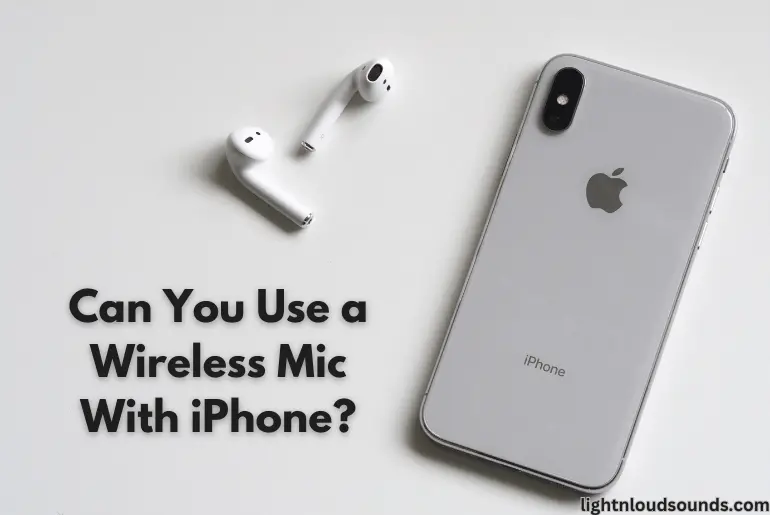Over the past few years, we’ve witnessed an impressive evolution in mobile filmmaking. From indie filmmakers to YouTubers creating entire vlogs using only their iPhones, the boundaries of what’s possible continue to expand.
However, while visual content often grabs our attention, high-quality audio is also very important. Sound adds depth, creates atmosphere, and connects us emotionally to the story or message being conveyed. In this post, we’ll look into one crucial aspect of this equation: the use of wireless mics with iPhones.
Post Contents
Can You Use a Wireless Mic With iPhone?
Yes, you can use a wireless microphone with an iPhone, either through a wireless receiver that connects to the iPhone’s Lightning port or by using a Bluetooth wireless microphone. The former involves the receiver having a TRS or TRRS connector that plugs into the iPhone, to which the microphone is then connected. On the other hand, Bluetooth microphones, which are gaining popularity for their convenience, can be paired directly with the iPhone for audio recording.
How to Connect a Wireless Mic to an iPhone
1. Using Bluetooth
Connecting a wireless microphone to your iPhone using Bluetooth is quite straightforward. To begin, make sure your wireless microphone has a Bluetooth feature. Start by turning on the Bluetooth option on your iPhone, which can be found in the settings menu under ‘Bluetooth’. Once activated, power on your microphone and set it to ‘Pairing’ mode.
Your iPhone should now detect the microphone, and it will appear in the list of available devices. Simply tap on the microphone’s name to pair. Once connected, any audio input from the microphone should be directed to your iPhone.
2. Using an audio interface or adapter
Recent iPhone models have seen a major shift from the traditional 3.5mm headphone jack to the exclusive Lightning port. This can pose a challenge when trying to connect devices that utilize the older jack.
However, Apple and other third-party manufacturers have developed adapters that can bridge this gap. One of the most common solutions is the Lightning to 3.5mm adapter. This adapter will be essential if your wireless mic receiver has a 3.5mm output. Alternatively, USB interfaces can connect directly to the iPhone’s Lightning or USB-C port for higher audio quality and more advanced setups.
3. Applications to monitor and record audio
Once your wireless mic is connected to your iPhone, you’ll want an application that can efficiently record and possibly even edit the audio. One of the most renowned apps for this purpose is Filmic Pro, particularly for those who are into mobile filmmaking. It allows for detailed audio monitoring and can capture high-quality sound.
For pure audio recording, Voice Record Pro is a popular choice, with a simple interface and a variety of formats and quality settings. Also, Apple’s very own GarageBand is not only for music creation but also an effective tool for recording spoken word, interviews, or any other type of audio.
Different Types of Wireless Mics Compatible with iPhone

1. Bluetooth microphones
Bluetooth microphones have risen in popularity due to their seamless integration with modern devices. Their biggest advantage lies in their easy connectivity; there’s no need for complex setups or adapters. Just pair your microphone with your iPhone, and you’re good to go.
Also, these microphones are widely available across different price ranges, making them accessible to most users. However, there are trade-offs. Bluetooth mics can sometimes exhibit latency, meaning there might be a tiny delay between the sound being captured and recorded on the device.
2. Digital wireless systems
For those who prioritize top-tier sound quality, digital wireless systems are the answer. These systems are designed to provide audio clarity that rivals wired mics, ensuring that your content is always of professional quality.
Also, they boast extremely low latency, so you never have to worry about syncing issues during post-production. The downside is that they come at a cost. Digital wireless systems tend to be pricier than their Bluetooth counterparts. Plus, depending on the model, you might need additional equipment or interfaces to connect them to your iPhone.
3. Lavalier (Lapel) microphones
Lavalier microphones, often referred to as lapel mics, are small clip-on devices designed to be attached to a person’s clothing, close to the mouth. They are discreet, making them perfect for video interviews where you don’t want a bulky microphone in the shot.
Their close proximity to the speaker’s mouth ensures consistent audio levels, even if the speaker turns their head or moves around. This makes lavalier mics ideal for on-the-go reporting, presentations, or any scenario where the speaker requires free movement without being tethered to a mic stand.
4. Handheld microphones
Handheld microphones are what most people picture when they think of a traditional microphone. These are designed to be held in the hand and are often used in scenarios like live performances, interviews, or broadcasts. Their design typically offers good rejection of ambient noise, focusing on the sound coming directly into the mic.
For iPhone users, handheld mics can be a powerful tool for scenarios like impromptu interviews or when a sturdy, reliable microphone is needed on the spot. While they might not offer the freedom of movement a lapel mic does, their robust build and sound quality make them a staple in many audio kits.
Conclusion
Choosing the right microphone can elevate the quality of your content, whether you’re into podcasting, mobile filmmaking, or live streaming. With iPhones, you have many options, each with its own advantages and limitations. From Bluetooth microphones to digital wireless systems, the choice ultimately boils down to your needs and budget.
Lavalier microphones offer unparalleled convenience for interviews and reporting, while handheld mics provide robust and reliable audio capture in a variety of settings. By understanding the strengths and weaknesses of each type, you can make an informed decision that will take your content creation to the next level.

